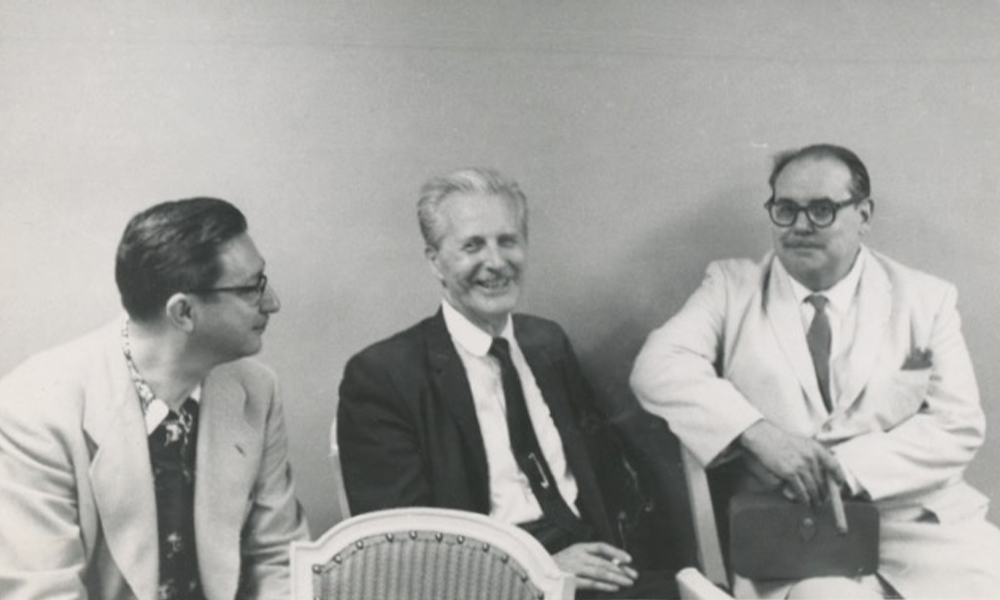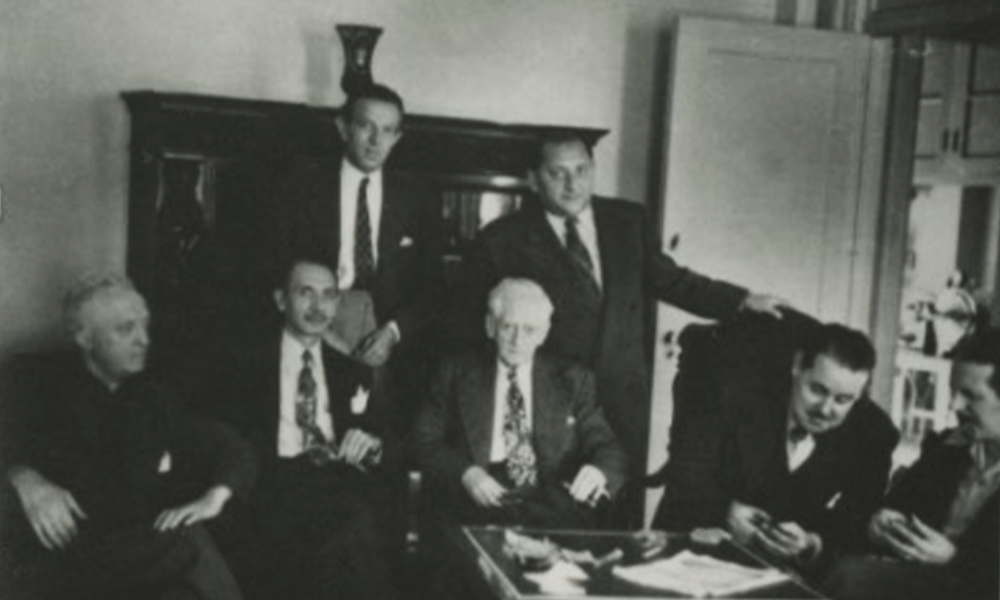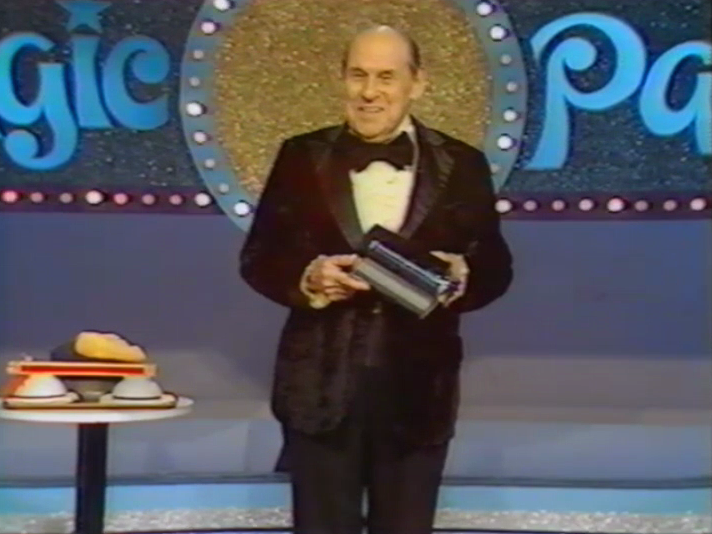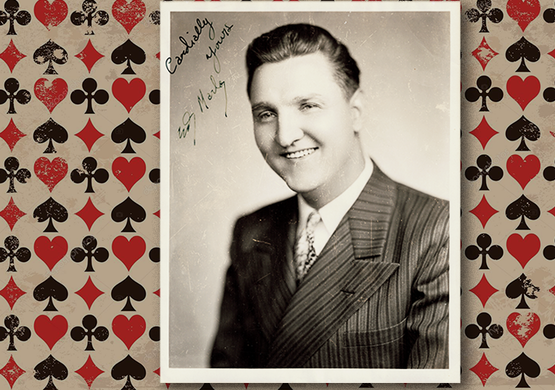Charles Earle Miller, the son of a successful Indianapolis piano maker, grew up as a privately tutored lad who spoke multiple languages (including Esperanto), and would delight in English wordplay throughout his life, including as a part of his eventual on-stage persona. As a young boy he became obsessed with magic, and although educated and trained as a watchmaker (providing fine mechanical skills that would serve him throughout his path in magic), magic would be the guiding thread of his unusual life.
Of the countless magicians connected with Dai Vernon’s long life in magic, perhaps no single name is more strongly associated than that of Charlie Miller. Their first introduction came through Vernon’s friend, Faucett Ross, to whom the young Miller wrote letters about Vernon’s work. Miller closely followed descriptions and reports of Vernon’s material in New York City magic dealer Max Holden’s column in the renowned magic journal, The Sphinx. Holden’s shop was a meeting place for elite of New York magic, and Holden would frequently describe Vernon’s amazing feats, absent any description of method. But the obsessive and brilliant young Miller studied the work, trying to solve the mysteries of Vernon’s magic. When Vernon met Ross in his Midwest home in 1932, Ross shared the correspondence, and the surprised Vernon would promptly write to Sam Horowitz, an expert colleague, that Miller had indeed accurately reconstructed Vernon’s work. And when Vernon and Miller would finally meet soon thereafter, Vernon would describe Miller as one of the two best card handlers Vernon had ever encountered. Although the two masters were a generation apart in age—a fact that magicians today often overlook—thus began a friendship and association that would last through Miller and Vernon’s lifetimes. Charlie Miller, albeit less renowned that Vernon, would eventually become a remarkable magical maestro in his own right.[i]
Vernon took Miller under his wing, and Miller came to share Vernon’s fascination with the techniques of professional card cheats. The two famously traveled together for a portion of Vernon’s pursuit of the Center Deal, an allegedly mythical cheating sleight that Vernon eventually succeeded in tracking down, along with its originator, Allen Kennedy (as recounted in The Magician and the Cardsharp, a fabulous read for the general public by journalist Karl Johnson). Miller would also come to share Vernon’s passion for his favorite and influential book (mentioned in Take Two #52), The Expert at the Card Table by S.W. Erdnase, and Miller would eventually be renowned among his circle for being able to execute literally every sleight in Erdnase to perfection, no matter how esoteric or challenging.
Vernon had sometimes associated with the underworld of the card cheat, and at a later period Miller himself would become deeply expert and knowledgeable in the hustler’s world, at times even being sought out for private lessons in the kind of real-world gambler’s sleight-of-hand at which he excelled. As Johnny Thompson has commented, “A lot of [Miller’s] card work came out of the gambling world. In fact, some of the material that’s around from the gambling world was introduced to magic by Charlie Miller.” Some of those items[ii] would appear in Expert Card Technique by Jean Hugard and Frederick Braue, one of the most important and influential books of card conjuring of the 20th century.

Indeed, Charlie claimed to be responsible for contributing a significant amount of material contained in the Hugard and Braue classic. Although there are several smaller manuscripts available of Miller’s material, Thompson recounts a time when someone asked Charlie when he was going to write a book, and Charlie replied, “I already have,” wryly implying Expert Card Technique. And Miller was also, albeit unintentionally, the source of a significant amount of un-credited material of Dai Vernon’s that eventually found its way into the book.[iii]
Miller’s passion for practice, as well as for intense analysis of every secret maneuver, is often attested to by his close circle of protégés. He insisted that Johnny Thompson practice the Erdnase one-handed shift in both hands, with the hands palm down, a feat few can match. He would practice false deals for endless hours in the dark, a way not only to prevent himself from developing the bad habit of watching his hands, but also so as to be able to match the sound of the various deals indistinguishable from one another. He would insist on watching a move from above, from the sides, from near and far, and even from beneath (lying on the floor!), before completing his critique or rendering his judgment. (When I once worked up the nerve to ask him to judge a particular sleight for which he was famous, after looking at it repeat executions and pronouncing it good, he added, “But of course, to really judge, I’d have to watch it in bright light, from a distance, and from underneath to really know for sure!”)
Indeed, Miller would eventually be recognized among Vernon’s innermost coterie as a virtual match for Vernon’s skills with cards. Noted Miller and Vernon acolyte Bob White has said, “This is just my personal opinion, but I’ve seen both and spent time with both. I think from a technical standpoint, Charlie was way ahead of Vernon, and I’ve heard on occasion that Vernon admitted it.”

Yet despite Miller’s extreme expertise and mastery of esoteric cardmanship, later in life he became impatient with “magic for magicians,” and enamored of performance magic that focused on artistry and entertainment, and the audience’s experience and perspective. In his sixties and seventies, after relocating to Los Angeles and performing regularly at the Magic Castle, where Dai Vernon had become situated as international guru in residence, Miller also worked on cruise ships performing his distinctly Victorian brand of stage magic, significantly guided in this direction by Faucett Ross. Charlie was also an accomplished ballroom dancer, and an element of his cruise ship work was dancing with older female passengers, earning him the cruise world nickname of “Twinkletoes.”
In addition to Ross’s significant influence, drawn from extensive correspondence as well as personal encounters, Miller’s stage magic tastes and performance style owed a direct line of influence to the legendary magician, Max Malini. Malini was a sui generis character and performer in the early 20th century, who performed in unconventional venues including in private homes, in self-produced hotel shows, and as an invited guest of European royalty and American presidents, featuring small magic that was effective larger settings because of his outsized personality.
Malini is a revered character in the annals of magic, thanks largely to the book, Malini and His Magic, written by Vernon amanuensis Lewis Ganson, but based almost entirely on material and accounts provided by Vernon. While Vernon knew and revered Malini, the two were not actually close, having fallen out over a dispute over Vernon’s performance of a Malini routine in a public venue where Malini was performing nearby. Malini was also famously secretive, and one of the few colleagues with whom he shared his secrets would be Charlie Miller; some of the methods in the Vernon book are pure speculation since Vernon lacked the firsthand knowledge that Miller possessed.
Decades later, when Miller would become more of a public performer late in life, he would bring to the stage much of what he had learned from Ross, Malini, Paul Fox and others, coupled with Miller’s distinct brand of Victorian deportment and language. Author Robert Parish would eventually and affectionately write that Charlie Miller “was born obsolete.” But Miller’s expertise was far from obsolete. Miller protégé John Thompson, among others, speaks as admiringly of Miller’s knowledge of small apparatus parlor and stage magic as he does of Miller’s knowledge of gambling technique, astonishing abilities with a pack of cards, and his encyclopedic mastery of the Cups and Balls. In Miller’s obituary penned by Thompson in 1989, Thompson, as legendary as a stage performer with his iconic Great Tomsoni & Co. act as he is as a close-up sleight-of-hand artist, wrote, “Without Charlie’s help and guidance I can truly say there would be no Johnny Thompson or Great Tomsoni. Of that I’m sure. His knowledge of stage deportment and stage magic was vast and unending.”

Charlie Miller was also a genuine eccentric, to a degree notable even among a world of magic eccentrics. As shy and socially awkward offstage as he was charming and engaging on stage, Miller became known among his friends as “America’s House Guest,” spending much of his adult life as a renowned “couch surfer” long before that term was ever in vogue. He lived in more than one city with his younger acolyte Harry Riser, shared living quarters in later years for a time with Johnny and Pam Thompson, and in Chicago resided upstairs at Jay and Francis Marshall’s famed “Magic, Inc.” establishment with little more than, as Harry Riser described it, “a cot and a bare bulb,” and which famously became known as “The Charlie Miller Suite.” (I confess to having slept there myself, but only for one night.)
By the time I had the privilege of spending a bit of time with Miller, in his last years in Los Angeles, I found a charming, sweet, man, with whom to sit at the Magic Castle bar, or a late night breakfast, and chat about any of a vast realm of oddities and observations that interested him. Invariably adorned with a gentleman’s purse and a winter scarf around his neck in the midst of Los Angeles’ endless summer weather, he remained a marvelous conversationalist, kind to a fault.
Miller profoundly influenced a select Who’s Who of magic, including Harry Riser, John Thompson, Bob White, Persi Diaconis, Ricky Jay, Steve Freeman, and John Carney. But the larger world of magic was and remains largely unaware of Miller’s standing, all the more so now, for a combination of reasons—partly being outshone by Vernon; partly because Miller was secretive about certain aspects of his work, particularly with regard to his gambling knowledge; and partly because he was never an ambitious self-promoter. Harry Riser, when asked to assess what Miller’s “most significant contribution to magic today,” without hesitation offered that the answer was “Preservation. Preservation is one of the major things … he’s the linkage between two different eras.” Yet that assessment may contain a note of unintentional irony, since the state of Miller’s legacy represents two warring schools of thought about weighing the value of legacy versus secrecy.
Most of Miller’s closest associates have respected his declared wishes to maintain his desire for secrecy. In the 19th century, the innovative and artistic Viennese card maestro, Johann Nepomuk Hofzinser, similarly wished his papers and secrets to die with him, but thanks to the efforts of students and historians, much of Hofzinser’s work survives, not only for the benefit of the art, its history, and its future practitioners, but also assuring that he receives proper credit due him for his many innovations, rather than mistakenly bestowing such credit on future re-inventors. But some of Charlie Miller’s greatest admirers may, in the name of secrecy, be most responsible for confining their mentor’s name to the margins of magical history. I confess the thought has occurred to me that a few of Miller and Vernon’s students failed to learn the number one lesson their generous mentors exemplified: namely, to pass it on.
For the moment, I am pleased to celebrate what I do know of the man so nice he would, by preference, invariably be named thrice when introduced on stage: Charlie Miller, Charlie Miller, Charlie Miller.
Footnotes
[i] My thanks to David Ben for clarifying these and other historical details.
[ii] For magicians: One notable example among many would be the popular cardician’s sleight, the “Up-the-Ladder Cut,” as the “Gamblers' False Cut.”
[iii] For magicians: Thompson reports that Charlie was responsible for all of the material from Jack McMillen; from Jack Merlin; most of the faro shuffle material, the math for which came from a gambler friend of Charlie’s in Indianapolis; and all the contributed material concerning Charlie’s famous mentor, Max Malini. Much of the unattributed material (including two now standard magical techniques) in ECT was also anonymously contributed by Charlie. And unintentionally, a quantity of unattributed items actually came from Dai Vernon, via “sessions” that Miller had with Fred Braue, and that Braue chose to record and publish without Miller’s or Vernon’s knowledge or permission; a fact that was an embarrassment to Charlie when this later came to be known, but for which Vernon entirely forgave him, on the record.) The expanded third edition of ECT contained an additional section of material attributed to Vernon and that helped, if indirectly, to balance the record in this regard).
Charlie Miller, Charlie Miller, Charlie Miller
As I have previously and frustratingly noted, at this time in history the work of elder masters and predecessors is often preserved in film and video made very late in their lives, sometimes when they are past their prime. This is true in the case of Dai Vernon, and it’s also true of Charlie Miller. Charlie made several marvelous videos for magicians, produced by Stevens Magic as part of the Greater Magic Video Library series, but while these videos remain highly instructive for magicians, they were done late in Miller’s life and do not represent his technical skills in his prime. He did make several appearances on The Magic Palace that are also shot fairly late in his life, but you can see charming performances of many of his signature routines, drawn from the canon of magical classics.
So please: Expand the browser. Turn up the volume. Put aside the smarth phone for the duration of these performances. Ladies and gentlemen, I now present to you: Charlie Miller, Charlie Miller, Charlie Miller!
In this appearance Charlie Miller performs several of his favorite routines, including the Magnetic Knives, a pet item of Max Malini’s. This entire performance is delightful.
This routine, now a rarely seen classic of small apparatus magic, was a signature piece of Miller’s thanks to his unique whistling presentation. I was fortunate to see Miller perform this on stage and found it utterly winsome.
From the documentary, “Ricky Jay: Deceptive Practice,” here Jay reminisces about learning how to practice from Miller, and this segment includes several all-to-brief clips of Miller in action at the card table in his prime.
For magicians: Here’s a link to a wonderful 75-minute conversation, hosted on Todd Vickers’ “Magic News Wire” podcast, between three older masters who all shared a common mentor in Charlie Miller, namely John Thompson, Harry Riser, and Bob White. I am fortunate to know all three of these men, and magicians are strongly encouraged to listen to these tales of Charlie Miller told by those who truly knew him.
The Magic Newswire No. 336: Charlie Miller
MORE: TAKE TWO ARCHIVE



